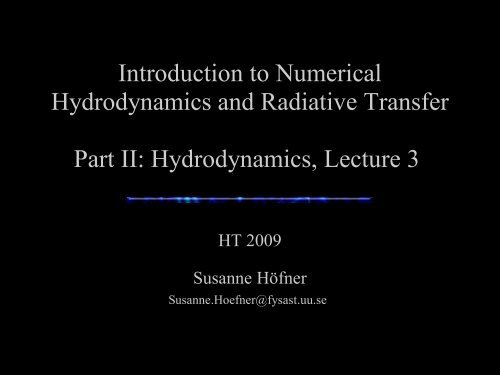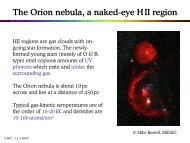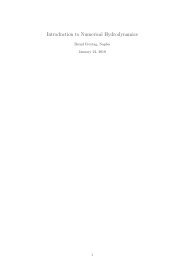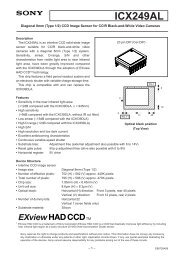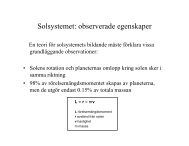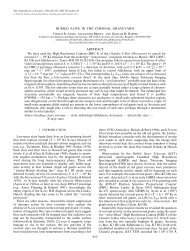lecture notes
lecture notes
lecture notes
You also want an ePaper? Increase the reach of your titles
YUMPU automatically turns print PDFs into web optimized ePapers that Google loves.
Introduction to Numerical<br />
Hydrodynamics and Radiative Transfer<br />
Part II: Hydrodynamics, Lecture 3<br />
HT 2009<br />
Susanne Höfner<br />
Susanne.Hoefner@fysast.uu.se
Introduction to Numerical Hydrodynamics<br />
2. The Linear Advection Equation<br />
2.3 Basic Concepts and Tools ... continued
Integral Form and Weak Solution<br />
Any solution of the advection equation in differential form<br />
involves derivatives.<br />
However, any function – even a discontinuous one – can be<br />
propagated along characteristics (see, e.g., Homework 1).<br />
In certain cases, it may be important to avoid derivatives and/or<br />
discontinuities.<br />
Transformation: linear advection equation in integral form:<br />
Definition: Solution of the PDE in integral form ↔ weak solution<br />
of the PDE in differential form.<br />
In smooth regions: weak solution = solution.
Integral Form and Flux Centering<br />
Any solution of the advection equation in differential form<br />
involves derivatives.<br />
However, any function – even a discontinuous one – can be<br />
propagated along characteristics (see, e.g., Homework 1).<br />
In certain cases, it may be important to avoid derivatives and/or<br />
discontinuities.<br />
Transformation: linear advection equation in integral form:<br />
Figure courtesy of Bernd Freytag<br />
... for one grid cell and one time step:
Centering of Quantities, Fluxes, and Differences<br />
Examples for “natural centering”:<br />
- quantities at grid points (integer i indices), e.g.:<br />
- spatial differences (half-integer i indices), e.g.:<br />
- time differences (half-integer n indices), e.g.:<br />
- fluxes at half-integer i indices (and, in fact, preferably at<br />
half-integer n indices) to get update properly centered:<br />
Effects of “natural centering”:<br />
is for and<br />
for<br />
is<br />
for
Update Formula in Conservation Form<br />
After computing the fluxes at the cell boundaries<br />
that characterize a method<br />
(e.g. from the fluxes in the cells: )<br />
the update can be done by the formula<br />
This is the conservation form because the density changes only<br />
due to fluxes through the boundaries, and is conserved otherwise:
Stencil Diagrams<br />
Any solution of the advection equation in differential form<br />
involves derivatives.<br />
However, any function – even a discontinuous one – can be<br />
propagated along characteristics (see, e.g., Homework 1).<br />
In certain cases, it may be important to avoid derivatives and/or<br />
dis<br />
The density at grid point i and time step n+1 depends on<br />
values at the old time step n (direct numerical domain of<br />
dependence, stencil)<br />
Figure courtesy of Bernd Freytag<br />
This is sketched in a so-called stencil diagram. On the other hand,<br />
the diagram shows also which points<br />
at the new time step n+1 are influenced by<br />
(range of influence).
Stencil Diagrams: Spatial Centering<br />
Any solution of the advection equation in differential form<br />
involves derivatives.<br />
However, any function – even a discontinuous one – can be<br />
propagated along characteristics (see, e.g., Homework 1).<br />
In certain cases, it may be important to avoid derivatives and/or<br />
dis<br />
The figure above shows stencil diagrams for 3 schemes with FT<br />
(forward-time) centering and different spatial centerings:<br />
- BS: backward-space (FTBS, left)<br />
- CS: center-space (FTCS, middle)<br />
- FS: forward-space (FTFS, right)<br />
Figures courtesy of Bernd Freytag
Stencil Diagrams: Centering in Time<br />
Any solution of the advection equation in differential form<br />
involves derivatives.<br />
However, any function – even a discontinuous one – can be<br />
propagated along characteristics (see, e.g., Homework 1).<br />
The figure above shows stencil diagrams for 4 schemes with CS<br />
(center-space) and different time centerings:<br />
- FT: forward-time (explicit)<br />
- time-centered implicit (implicit)<br />
- BT: backward-time (fully implicit)<br />
- CT, Leapfrog: center-time (explicit, uses 3 time planes)<br />
In implicit schemes each value at the new time level typically<br />
depends on all values at the old level: The full domain of<br />
dependence is larger than the direct domain of dependence.<br />
Figures courtesy of Bernd Freytag
Domain of Dependence and CFL Condition<br />
Hyperbolic PDEs have a finite physical domain of dependence due<br />
to the finite travelling speed of waves (↔ characteristics).<br />
Courant-Friedrichs-Levy condition (CFL condition):<br />
The numerical domain of dependence must contain the physical<br />
domain of dependence.<br />
The CFL condition is necessary for stability, but not sufficient.
Domain of Dependence and CFL Condition<br />
CFL condition limits ∆t for given<br />
stencil, ∆x and flow velocity<br />
✘<br />
✓<br />
Hyperbolic PDEs have a finite physical domain of dependence due<br />
to the finite travelling speed of waves (↔ characteristics).<br />
Courant-Friedrichs-Levy condition (CFL condition):<br />
The numerical domain of dependence must contain the physical<br />
domain of dependence.<br />
The CFL condition is necessary for stability, but not sufficient.
Domain of Dependence and CFL Condition<br />
CFL condition limits ∆t for given<br />
stencil, ∆x and flow velocity<br />
✘<br />
✓<br />
Hyperbolic PDEs have a finite physical domain of dependence due<br />
to the finite travelling speed of waves (↔ characteristics).<br />
Example: linear advection equation<br />
constant flow velocity (everywhere, at all times) →<br />
characteristics = straight lines, slope corresponding to velocity<br />
physical domain of dependence = starting point of characteristic
Truncation Error<br />
A sufficiently smooth function can be expanded in a Taylor series:<br />
Solving for<br />
gives<br />
Repeating this for the time derivative and applying it to an entire<br />
PDE (FTFS) gives<br />
The order of the truncation error is<br />
in this case (FTFS).<br />
A high order of the truncation error hints at good accuracy for<br />
smooth functions.
Consistency – Stability – Convergence<br />
Consistency: A numerical scheme is consistent if its discrete<br />
operator (with finite differences) converges towards the<br />
continuous operator (with derivatives) of the PDE for ∆t, ∆x → 0<br />
(vanishing truncation error).<br />
Stability: “Noise” (from initial conditions, round-off errors, ...)<br />
does not grow.<br />
Convergence: The solution of the numerical scheme converges<br />
towards the real solution of the PDE for ∆t, ∆x → 0<br />
Lax's equivalence theorem: “Given a properly posed initial value<br />
problem and a finite difference approximation to it that satisfies<br />
the consistency condition, stability is the necessary and sufficient<br />
condition for convergence.”
Introduction to Numerical Hydrodynamics<br />
2. The Linear Advection Equation<br />
2.4 Examples of Numerical Schemes
Parameters of the Following Examples<br />
Boundary conditions influence the properties of real world<br />
hydrodynamic flows.<br />
Linear 1D advection: infinite domain without boundaries<br />
Actual implementation of boundary conditions in numerical<br />
experiments: adding ghost cells, number depends on stencil.<br />
In the following examples: periodic boundary conditions<br />
v∆t/ ∆x = 0.4 (Courant Number)<br />
200 grid points<br />
500 time steps<br />
⇒ one full cycle<br />
Initial condition: “spikes” (Gaussian, rectangle, triangle, halfellipse),<br />
see Jiang & Shu (1996)
Parameters of the Following Examples<br />
Boundary conditions influence the properties of real world<br />
hydrodynamic flows.<br />
Linear 1D advection: infinite domain without boundaries<br />
Actual implementation of boundary conditions in numerical<br />
experiments: adding ghost cells, number depends on stencil.<br />
In the following examples: periodic boundary conditions<br />
v∆t/ ∆x = 0.4 (Courant Number)<br />
200 grid points update formula:<br />
500 time steps<br />
⇒ one full cycle<br />
Initial condition: “spikes” (Gaussian, rectangle, triangle, halfellipse),<br />
see Jiang & Shu (1996)
Linear Advection – Naïve FTCS Scheme<br />
∂ y<br />
∂t<br />
= D ∂2 y<br />
∂ x 2<br />
Figures courtesy of Bernd Freytag<br />
Stencil diagram and (disastrous) test result (initial condition: red,<br />
solution: blue) for explicit Euler scheme (FTCS) with flux at<br />
The oscillations already seen earlier grow exponentially. After<br />
some time the numerical result does not have the faintest<br />
resemblance with the true solution.
Linear Advection – Implicit Centered Scheme<br />
∂ y<br />
∂t<br />
= D ∂2 y<br />
∂ x 2<br />
Figures courtesy of Bernd Freytag<br />
Stencil diagram and test result (initial condition: red, solution:<br />
blue) for implicit centered scheme with flux<br />
The centering of the scheme in space and time seems promising.<br />
However, the initial conditions is severely distorted.
Linear Advection – BTCS Scheme<br />
∂ y<br />
∂t<br />
= D ∂2 y<br />
∂ x 2<br />
Figures courtesy of Bernd Freytag<br />
Stencil diagram and test result (initial condition: red, solution:<br />
blue) for fully implicit BTCS scheme with flux<br />
The fully implicit treatment takes effect: the result looks almost<br />
smooth (with some non-decaying small-scale wiggles) but is<br />
smeared out heavily.
Linear Advection – Donor Cell (FTBS) Scheme<br />
∂ y<br />
∂t<br />
= D ∂2 y<br />
∂ x 2<br />
Figures courtesy of Bernd Freytag<br />
Stencil diagram and test result (initial condition: red, solution:<br />
blue) for donor cell (FTBS) scheme with flux<br />
The result is wonderfully smooth but smeared out severely.<br />
Upwinding seems promising to achieve stability. However, the<br />
accuracy of the scheme has to be improved.
Linear Advection – FTFS Scheme<br />
∂ y<br />
∂t<br />
= D ∂2 y<br />
∂ x 2<br />
Figures courtesy of Bernd Freytag<br />
Stencil diagram and (disastrous) test result (initial condition: red,<br />
solution: blue) for FTFS scheme with flux<br />
Small-scale oscillations grow even faster than for the naïve scheme<br />
and render the FTFS scheme useless (for ).
Linear Advection – Lax-Friedrichs Scheme<br />
∂ y<br />
∂t<br />
= D ∂2 y<br />
∂ x 2<br />
Figures courtesy of Bernd Freytag<br />
Stencil diagram and test result (initial condition: red, solution:<br />
blue) for Lax-Friedrichs scheme with flux<br />
The smearing is so strong that not even the number of initial<br />
spikes is conserved. And there are some non-decaying small-scale<br />
wiggles left. Note: odd-even decoupling.
Linear Advection – Lax-Wendroff Scheme<br />
∂ y<br />
∂t<br />
= D ∂2 y<br />
∂ x 2<br />
Figures courtesy of Bernd Freytag<br />
Stencil diagram and test result (initial condition: red, solution:<br />
blue) for Lax-Wendroff scheme ( ) with flux<br />
The result is smooth with considerable overshoot (that does not<br />
grow much with time any more). This second order scheme might<br />
be useful for more regular initial conditions.
Linear Advection – Beam-Warming Scheme<br />
∂ y<br />
∂t<br />
= D ∂2 y<br />
∂ x 2<br />
Figures courtesy of Bernd Freytag<br />
Stencil diagram and test result (initial condition: red, solution:<br />
blue) for Beam-Warming scheme ( ) with flux<br />
The result is smooth with considerable overshoot (that does not<br />
grow much with time any more). This second order scheme might<br />
be useful for more regular initial conditions.
Linear Advection – Fromm Scheme<br />
∂ y<br />
∂t<br />
= D ∂2 y<br />
∂ x 2<br />
Figures courtesy of Bernd Freytag<br />
Stencil diagram and test result (initial condition: red, solution:<br />
blue) for Fromm scheme ( ) with flux<br />
The result is smooth with some amount of overshoot. The initial<br />
shape of the spikes is recognizable. So far the best scheme, if the<br />
overshoot can be accepted.
The Linear Advection Equation – Homework 2<br />
Compute the numerical solution of the linear advection equation<br />
∂ <br />
∂ t<br />
u ∂ <br />
∂ x = 0<br />
in the range 0 ≤ x ≤ 1, with the initial conditions<br />
0<br />
x = 1 for x0 and 0<br />
x = 0 for x0<br />
assuming u=1 and ∆t/∆x = 0.5, for different numerical schemes:<br />
(a) Lax-Friedrichs, (b) Lax-Wendroff and (c) Beam-Warming.<br />
Plot the resulting numerical solutions and the exact analytical<br />
solution at time t = 0.5 for the cases ∆x = 0.01 and ∆x = 0.0025,<br />
and compare the results to the upwind (donor cell) scheme (see<br />
homework 1).


